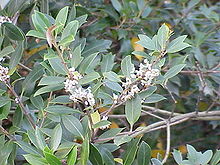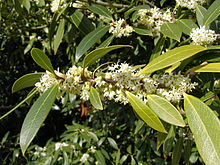- Osmanthus
-
Osmanthus 
Osmanthus heterophyllus in flower Scientific classification Kingdom: Plantae (unranked): Angiosperms (unranked): Eudicots (unranked): Asterids Order: Lamiales Family: Oleaceae Tribe: Oleeae Genus: Osmanthus
Lour.Species About 30 species; see text.
Osmanthus (
 /ɒzˈmænθəs/)[1] is a genus of about 30 species of flowering plants in the family Oleaceae, mostly native to warm temperate Asia (from the Caucasus east to Japan) but one species (O. americanus) occurring in North America (southeastern United States, Texas to Virginia). It is sometimes included in Nestegis. They range in size from shrubs to small trees, 2-12 m tall. The leaves are opposite, evergreen, and simple, with an entire, serrated or coarsely toothed margin. The flowers are produced in spring, summer or autumn, each flower being about 1 cm long, white, with a four-lobed tubular-based corolla ('petals'). The flowers grow in small panicles, and in several species have a strong fragrance. The fruit is a small (10-15 mm), hard-skinned dark blue to purple drupe containing a single seed.
/ɒzˈmænθəs/)[1] is a genus of about 30 species of flowering plants in the family Oleaceae, mostly native to warm temperate Asia (from the Caucasus east to Japan) but one species (O. americanus) occurring in North America (southeastern United States, Texas to Virginia). It is sometimes included in Nestegis. They range in size from shrubs to small trees, 2-12 m tall. The leaves are opposite, evergreen, and simple, with an entire, serrated or coarsely toothed margin. The flowers are produced in spring, summer or autumn, each flower being about 1 cm long, white, with a four-lobed tubular-based corolla ('petals'). The flowers grow in small panicles, and in several species have a strong fragrance. The fruit is a small (10-15 mm), hard-skinned dark blue to purple drupe containing a single seed.- Selected species
- Osmanthus americanus - Devilwood Osmanthus or Devilwood
- Osmanthus armatus
- Osmanthus asiaticus - Sweet Olive
- Osmanthus auratiacus
- Osmanthus decorus - Caucasian Osmanthus
- Osmanthus delavayi - Delavay's Osmanthus
- Osmanthus fragrans - Sweet Osmanthus
- Osmanthus heterophyllus - Chinese Osmanthus
- Osmanthus serrulatus
- Osmanthus suavis
- Osmanthus yunnanensis - Yunnan Osmanthus
- Garden hybrids
- Osmanthus × burkwoodii (O. delavayi × O. decorus)
- Osmanthus × fortunei (O. fragrans × O. heterophyllus)
Cultivation and uses
Osmanthus are popular shrubs in parks and gardens throughout the warm temperate zone. Several hybrids and cultivars have been developed. In China, osmanthus tea (Chinese: 桂花茶; pinyin: guìhuā chá) is produced by combining dried Sweet Osmanthus (Osmanthus fragrans) flowers (Chinese: 桂花; pinyin: guìhuā) with black or green tea leaves in much the same manner the more familiar jasmine tea combines jasmine flowers with tea leaves. In Japan, Osmanthus asiaticus or Sweet Olive is a favourite garden shrub. Known as Gin-mokusei, its small white flowers appear in short stalked clusters in late autumn. It has an intense sweet fragrance which has been described as a blend of jasmine, gardenia and ripe apricots. Another variant popular in Japan is Osmanthus aurantiacus, also known as Kin-mokusei. Very similar to the Sweet Olive but has deep, golden flowers.
Osmanthus oil derived from the flowers has become a popular ingredient in the niche perfume industry in the last decade since the launch of Ormonde Jayne Perfumery's perfume Osmanthus ABsolute. The Different Company, Tom Ford and Space NK have all since launched their own Osmanthus perfume.
Osmanthus flower on old wood, and produce more flowers if unpruned. If pruned, the plant responds by producing fast-growing young vegetative growth with no flowers, in an attempt to restore the removed branches; a pruned shrub often produces few or no flowers for one to five or more years, before the new growth matures sufficiently to start flowering.
References
- ^ Sunset Western Garden Book, 1995:606–607
In 2003, the perfume house Ormonde Jayne launched Osmanthus Absolute, the first perfume built on the single note of osmanthus
External links
Categories:
Wikimedia Foundation. 2010.

